Universe and Space Science | Chapter 8 | 8th Science - IndiaŌĆÖs Space Programmes | 8th Science : Chapter 8 : Universe and Space Science
Chapter: 8th Science : Chapter 8 : Universe and Space Science
IndiaŌĆÖs Space Programmes
IndiaŌĆÖs Space Programmes
Soon after independence, India initiated space research activities. In 1969, Indian Space Research Organisation (ISRO) was formed with the objective of developing space technology and its application for different needs of the nation. India is focusing on satellites for communication and remote sensing, space transportation systems and application programmes. The first ever satellite Aryabhata was launched in 1975. Since then India has achieved a lot in space programmes equal to that of the developed nations.
Activity 3
With the help of your teacher gather information about the achievements of India in space research. Prepare an album about the satellite programmes of India.
Rakesh Sharma, an Indian pilot from Punjab was selected as a ŌĆśCosmonautŌĆÖ in a joint space program between India and Soviet Russia and become the first Indian to enter into the space on 2nd April, 1984.
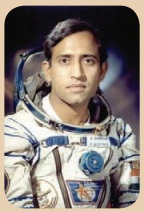
1. Chandrayaan - 1
Our country launched a satellite Chandrayaan -1 (meaning Moon vehicle) on 22nd October 2008 to study about the Moon. It was launched from Sathish Dhawan Space Center in Sriharikota, Andhra Pradesh with the help of PSLV (Polar Satellite Launch Vehicle) rocket. It was put into the lunar orbit on 8th November 2008.
The spacecraft was orbiting around the Moon at a height of 100 km from the lunar surface. It collected the chemical, the mineralogical and the geological information about the Moon. This mission was a major boost for the Indian space programs and helped to develop its own technology to explore the Moon. Chandrayaan-1 was operated for 312 days and achieved 95% of its objectives. The scientists lost their communication with the space craft on 28th August 2009. On the successful completion of all the major objectives, the mission was concluded.
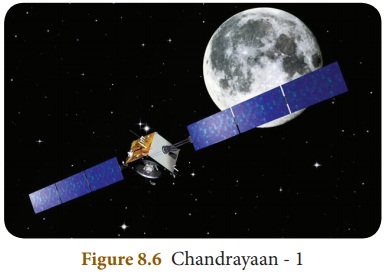
a. Objectives of Chandrayaan-1
The following are the objectives of Chandrayaan ŌĆō 1 mission.
* To find the possibility of water on the Moon.
* To find the elements of matter on the Moon.
* To search for the existence of Helium-3.
* To make a 3-dimensional atlas of the Moon.
* To study about the evolution of the solar system.
Kalam Sat is the worldŌĆÖs smallest satellite weighing only 64 gram. It was built by a team of high school students, led by Rifath Sharook, an 18 year old school student from ŌĆśPallapattiŌĆÖ nearKarur, Tamil Nadu. It was launched into the space on 22nd June 2017 by NASA.
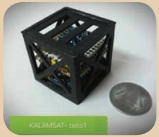
b. Achievements of Chandrayaan-1
The following are the achievements of Chandrayaan-1 mission.
* The discovery of presence of water molecules in the lunar soil.
* Chandrayaan-1 confirmed that the Moon was completely molten once.
* Chandrayaan-1 has recorded images of the landing site of the US space-craft Apollo-15 and Apollo-11.
Know your Scientist Dr. Mylsamy Annadurai was born on 2nd July1958, at Kodhavadi, a small village near Pollachi in Coimbatore district. He pursued his B. E.degree course at Government College of Technology, Coimbatore. In 1982, he pursued his higher education and acquired an M.E. degree at PSG College of Technology, Coimbatore. In the same year he joined the ISRO as a scientist. And later, he got his doctorate degree from Anna University of Technology, Coimbatore. Annadurai is a leading technologist in the field of satellite system. He has served as the Project Director of Chandrayaan-1. He has also made significant contributions to the cost effective design of Chandrayaan.
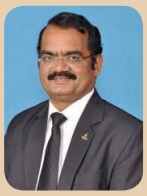
* It has provided high-resolution spectral data on the mineralogy of the Moon.
* The existence of aluminium, magnesium and silicon were picked up by the X-ray camera.
* More than 40,000 images have been transmitted by the Chandrayaan-1 camera in 75 days.
* The acquired images of peaks and craters show that the Moon mostly consists of craters.
* Chandrayaan-1 beamed back its first images of the Earth in its entirety.
* Chandrayaan-1 has discovered large caves on the lunar surface that can act as human shelter on the Moon.
2. Mangalyaan (Mars vehicle)
After the successful launch of Chandrayaan-1, ISRO planned an unmanned mission to Mars (Mars Orbiter Mission) and launched a space probe (space vehicle) on 5th November 2013 to orbit Mars orbit. This probe was launched by the PSLV Rocket from Sriharikota, Andra pradesh. Mars Orbiter Mission is IndiaŌĆÖs first interplanetary mission. By launching Mangalyaan, ISRO became the fourth space agency to reach Mars.
Mangalyaan probe traveled for about a month in EarthŌĆÖs orbit, and then it was moved to the orbit of Mars by a series of projections. It was successfully placed in the Mars-orbit on 24th September 2014.
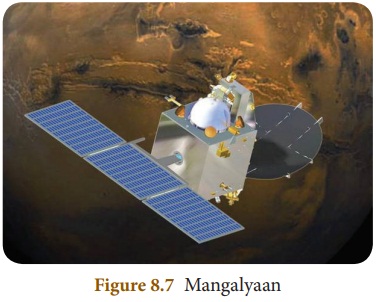
Mars Orbiter Mission (MOM) successfully completed a period of 3 years in the Martian orbit and continues to work as expected. ISRO has released the scientific data received from the Mangalyaan in the past two years (up to September 2016).
More to know
Mars is the fourth planet from the Sun. It is the second smallest planet in the solar system. Mars is called as the Red Planet because of its reddish colour. Iron Oxide present in its surface and also in its dusty atmosphere gives the reddish colour to that planet. Mars rotates about its own axis once in 24 hours 37 minutes. Mars revolves around the Sun once in 687 days. The rotational period and seasonal cycles of Mars are similar to that of the Earth. Astronomers are more curious in the exploration of Mars. So, they have sent many unmanned spacecrafts to study the planetŌĆÖs surface, climate, and geology.
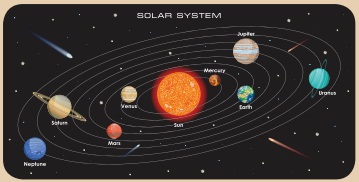
Activity 4
Gather information about the planets in the solar system. Can we reach all the planets in the solar system? Discuss in the class room.
a. Objectives of Mangalyaan
The following are the objectives of Mangalyaan mission.
ŌĆó To develop the technology required for interplanetary mission.
ŌĆó To explore the surface of Mars.
ŌĆó To study the constituents of the atmosphere of Mars.
ŌĆó To provide information about the future possibility of life and past existence of life on the planet.
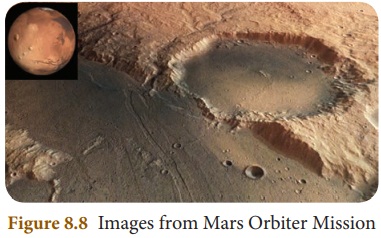
India became the first Asian country to reach Mars and the first nation in the world to achieve this in the first attempt. Soviet Space Program, NASA, and European Space Agency are the three other agencies that reached Mars before ISRO.
3. Chandrayaan - 2
ISRO has currently launched a follow on mission to Chandrayaan-1 named as Chandrayaan-2, on 22nd July 2019. Chandrayaan-2 mission is highly complex mission compared to previous missions of ISRO. It brought together an Orbiter, Lander and Rover. It aims to explore South Pole of the Moon because the surface area of the South Pole remines in shadow much larger than that of North Pole.
Orbiter
It revolves around the moon and it is capable of communicating with Indian Deep Space Network (IDSN) at Bylalu as well as Vikram Lander.
Lander
It is named as Vikram in the memory of Dr.Vikram A. Sarabhai, the father of Indian space program.
Rover
It is a six wheeled robotic vehicle named as ŌĆśPragyanŌĆÖ (Sanskrit word) that means wisdom. Chandrayaan-2 was successfully inserted into the lunar orbit on 20th August 2019. In the final tage of the mission, just 2. 1 km above the lunar surface, Lander ŌĆśVikramŌĆÖ lost its communication with the ground station on 7th September 2019. But the Orbiter continues its work successfully.
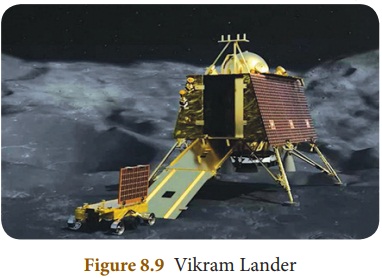
Know your Scientist Dr. Kailasa Vadivoo Sivan is the chairperson of the Indian Space Research Organization (ISRO). He was born in Sarakkalvilai, in Kanyakumari district of Tamil Nadu. Sivan graduated with a bachelorŌĆÖs degree in Aeronautical Engineering from Madras Institute of Technology in 1980. Then he got his masterŌĆÖs degree in Aerospace Engineering from Indian Institute of Science, Bangalore in 1982, and started working in ISRO. He completed his doctoral degree in Aerospace Engineering from Indian Institute of Technology, Bombay in 2006. He was appointed as Chairman of ISRO from 10th January 2018. Sivan is popularly known as the ŌĆśRocket ManŌĆÖ for his significant contribution to the development of cryogenic engines for IndiaŌĆÖs space programs. The ability of ŌĆśISROŌĆÖ to send 104 satellites in a single mission is a great example of his expertise.
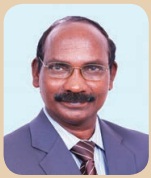
More to know
The Moon is the only natural satellite of the Earth. It is at a mean distance of about 3,84,400 km from the Earth. Its diameter is 3,474 km. It has no atmosphere of its own. It doesnŌĆÖt have its own light, but it reflects the sunlight. The time period of rotation of the Moon about its own axis is equal to the time period of revolution around the Earth. ThatŌĆÖs why we are always seeing its one side alone.
Related Topics